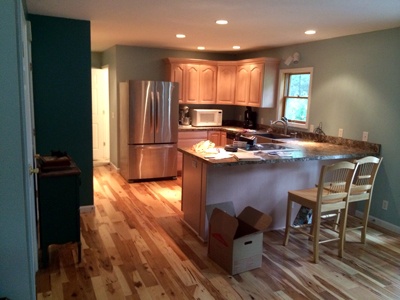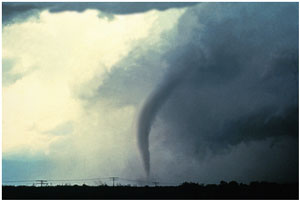Don’t Be Caught with a Flooded Basement This Spring
(Part I of II)
 Just because the snow is gone doesn’t mean you’re past the danger of a flooded basement. The ground is still frozen and in the process of thawing when the spring rains come, therefore, the ground is too saturated and/or frozen to absorb the water. The water then flows down the easiest path which is usually to your foundation wall and into your basement.
Just because the snow is gone doesn’t mean you’re past the danger of a flooded basement. The ground is still frozen and in the process of thawing when the spring rains come, therefore, the ground is too saturated and/or frozen to absorb the water. The water then flows down the easiest path which is usually to your foundation wall and into your basement.
The Biggest Causes of Basement Flooding
Sump pumps can help filter water out of your basement when they’re working properly; however, there are many things that can go wrong with a sump pump at the wrong time. For instance, it can fail due to age, continuous use can burn up the motor, debris in the basin can block flow, the “check” valve fails, or the weep hole or filter can get clogged.
Other problems that can lead to flooding are from municipal infrastructure malfunctions. A sanitary sewer pipe is designed to remove wastewater from your home (i.e. toilets, sinks, floor drains, and can include your weep tiles around your foundation, etc). If excess storm water enters the sanitary sewer system, it can overload the system and send it back into your house (usually if the fixtures or drains are below the surcharge level). The same thing can happen with a storm sewer that’s usually larger than the sanitary sewer, but designed to carry larger amounts of flow.
Your landscaping can also contribute to a flooded basement. When the ground around your foundation slopes toward the house, the rainwater naturally flows in the sloped direction. In most cases, your weeping tiles will carry the water away without issue, but at some point the water could overload the system and find its way into the foundation walls. The same goes for window wells, so slope away from them, too.
Another cause could be your eaves troughs and downspouts. Do your downspouts extend at least 6’ away from your foundation wall? If not, the water could overload your weeping tiles. Are they still plugged from fall with pine needles or leaves? Do you see water over flowing from the gutter in the center of your house?
Solutions to These Problems:
When you have an unexplained flooding problem, start first at the eaves troughs and downspouts, and then look at your landscaping and foundation drainage, then to sewer/sanitary drains and finally, the interior plumbing.
1) Keep the gutters and downspouts clean of debris, check for cracks (especially at the connections). Have the downspouts out 6’ from your foundation. If they still spill over in heavy rains replace them with a larger size.
2) The ground around your home settles and can slope towards your foundation, fill it in and grade the lot so it slopes away from the house at least 6’.
3) It’s difficult to determine whether you have weeping tile problems, but if the source of the water can’t be found it’s probably time to hire a company with a camera to snake the drains and see if you have a crushed tile or plug. This would also determine if this is in the sanitary or storm drain. (Usually if water or sewer is coming up through your drains in the floor or through a basement shower drain this is external backup).
4) Last, but not least, the Sump Pump. Make sure the discharge pipe is free of debris and discharged out into your property where it can be absorbed, such as your lawn or garden. Next, make sure the pit is cleaned each year as the weeping tiles can carry small amounts of sand or debris into the pit. Check and test your pump each spring (can check by pouring water into the pit until the pump kicks on). Remove and clean the pump once a year. Always disconnect the power source before working on the pump. Check once a month for debris in the pit.
A good back up for the sump pump is a battery backup that will kick on when you lose power from a storm. There are a variety of backups and some that have an audible alarm or can call your phone to notify you of a power outage. There is also a backwater valve that prevents sewage from backing up into your basement, ask a plumbing company.
Part II - Flooding Saftey & Preparedness
 Most often, home or business owners look to their insurance adjusters for direction in the event of a fire, flood, storm or vehicle impact emergency. They want to know who should they call immediately, and then who should they call to clean-up the mayhem, and finally who can reconstruct the damage back to pre-disaster status? And understandably, they want each stage handled quickly.
Most often, home or business owners look to their insurance adjusters for direction in the event of a fire, flood, storm or vehicle impact emergency. They want to know who should they call immediately, and then who should they call to clean-up the mayhem, and finally who can reconstruct the damage back to pre-disaster status? And understandably, they want each stage handled quickly.


 The storm has passed. No one was hurt. However, the house wasn’t so lucky. “Now what do we do?”
The storm has passed. No one was hurt. However, the house wasn’t so lucky. “Now what do we do?” 
 HOW SERIOUS IS BASEMENT FLOODING:
HOW SERIOUS IS BASEMENT FLOODING: Just because the snow is gone doesn’t mean you’re past the danger of a flooded basement. The ground is still frozen and in the process of thawing when the spring rains come, therefore, the ground is too saturated and/or frozen to absorb the water. The water then flows down the easiest path which is usually to your foundation wall and into your basement.
Just because the snow is gone doesn’t mean you’re past the danger of a flooded basement. The ground is still frozen and in the process of thawing when the spring rains come, therefore, the ground is too saturated and/or frozen to absorb the water. The water then flows down the easiest path which is usually to your foundation wall and into your basement.